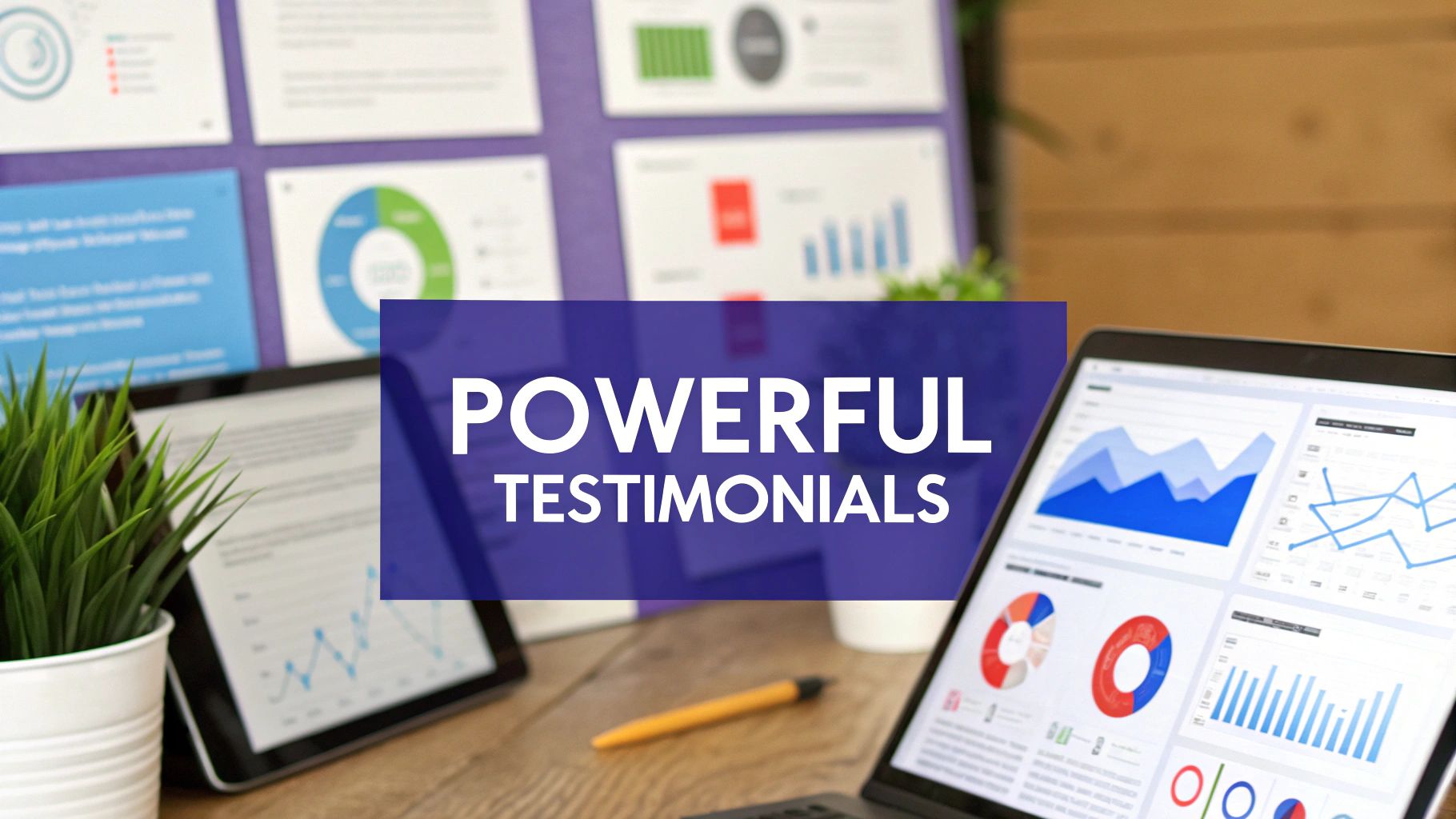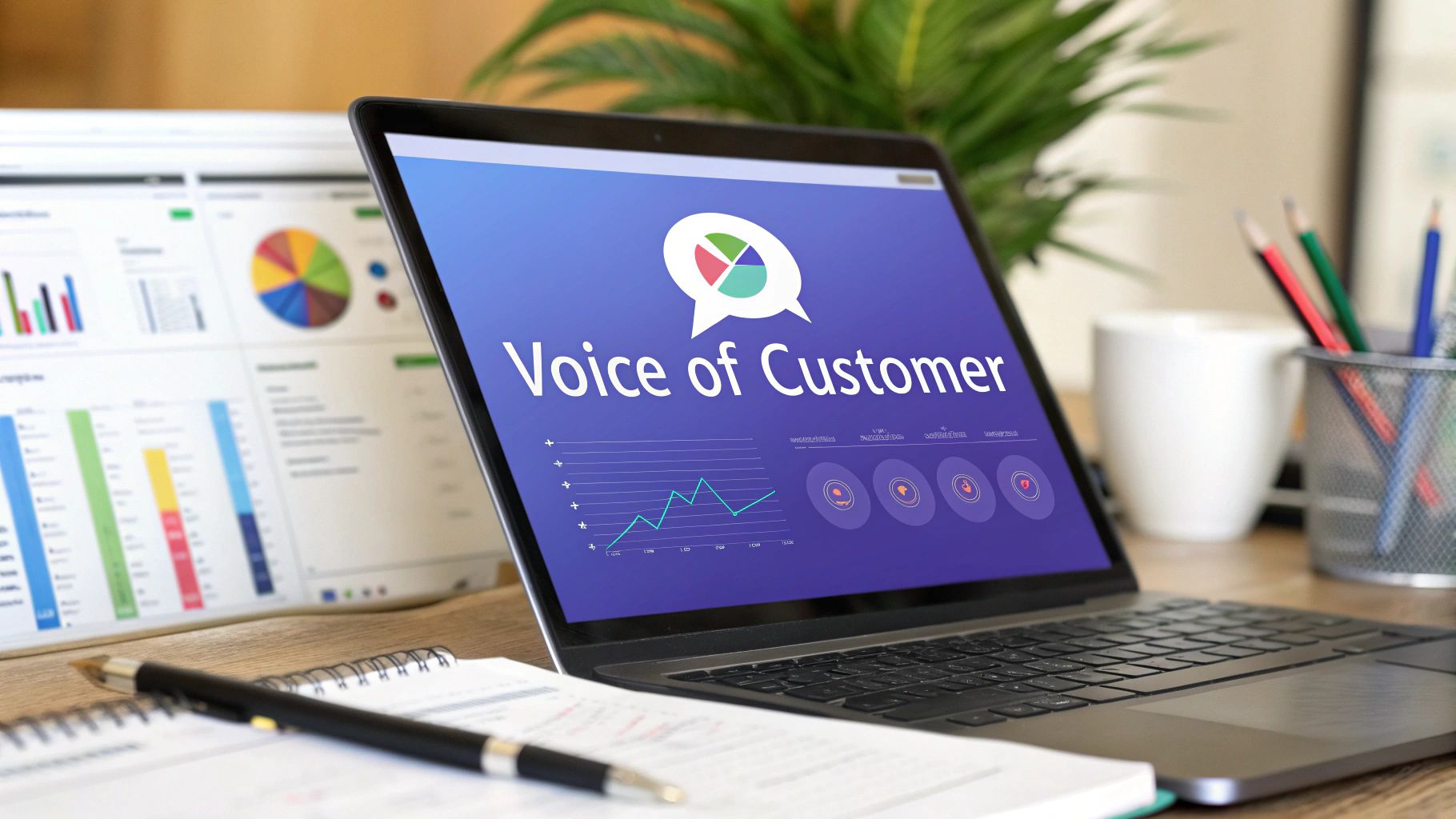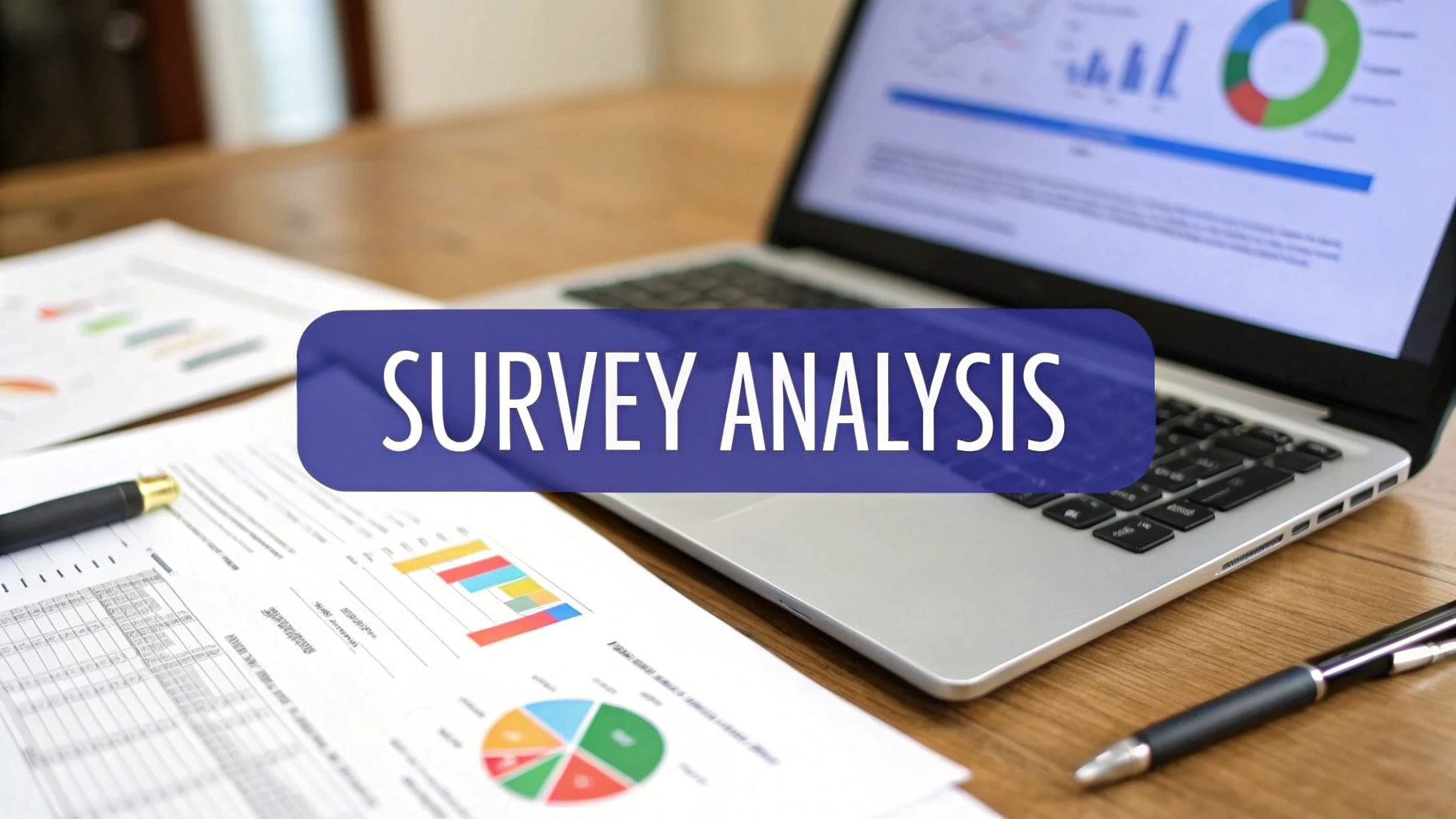How to Increase G2 Reviews With Surveys: Simple Tactics
Learn how to increase g2 reviews with surveys using proven, easy-to-implement methods to boost credibility and feedback.
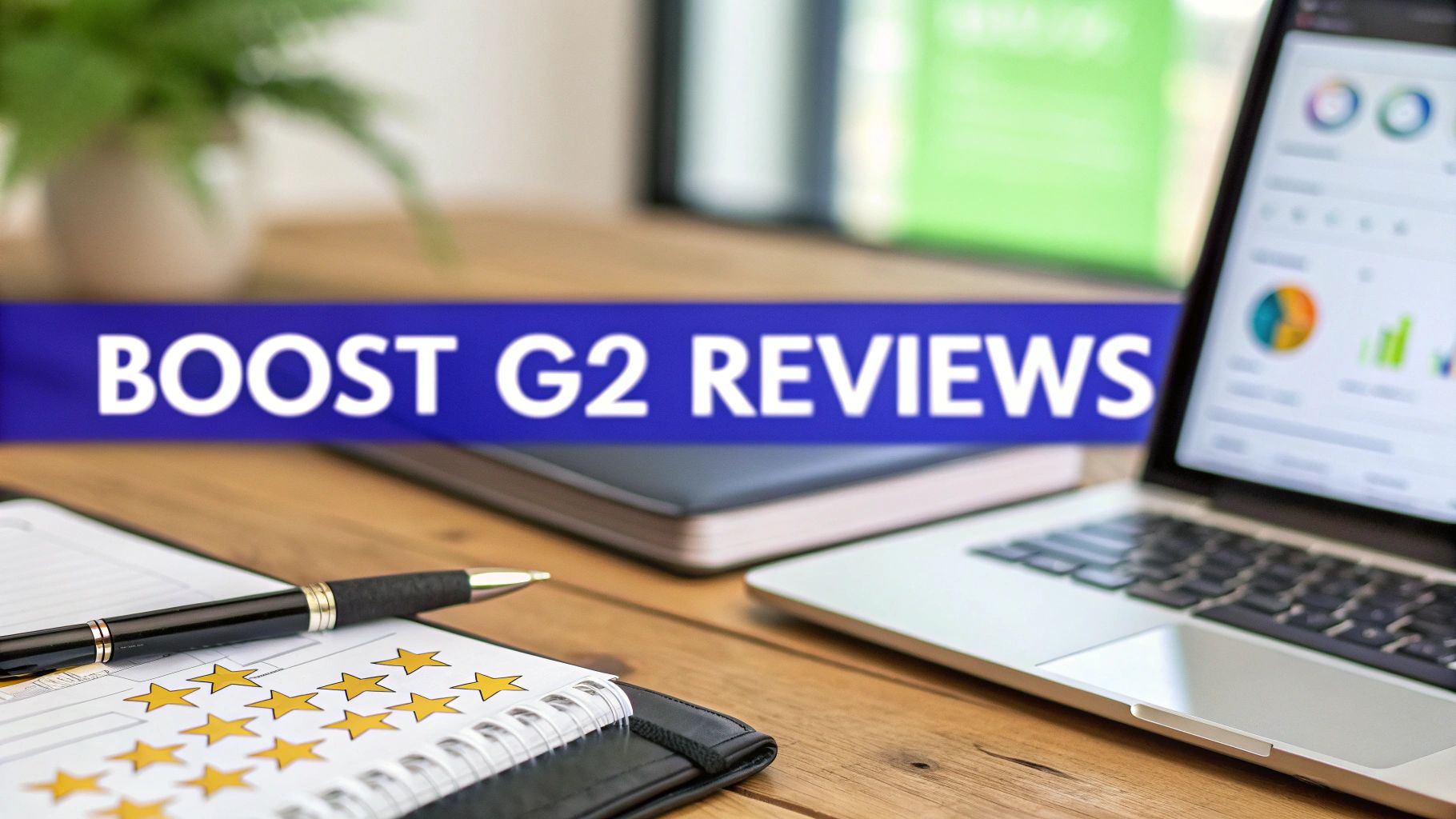
Getting more G2 reviews isn't about sending a request to your entire customer list and hoping for the best. A better way is to systematically find your happiest, most engaged users and make it easy for them to share their good experiences.
This is where targeted surveys, like the Net Promoter Score (NPS), are useful. You use them to pinpoint your biggest fans and then follow up with a direct, personal request to share their experience on G2. It’s a focused approach that works far better than a general request.
Why Surveys Are a Goldmine for G2 Reviews
Trying to get G2 reviews with mass emails often feels like a lottery you never win. You send out a generic request, cross your fingers, and usually end up with disappointing results. A strategic survey completely changes this approach.
Think of it as a filter. Instead of guessing who your advocates are, surveys give you hard data. A high NPS score or glowing feedback on a customer satisfaction (CSAT) survey is a massive green flag. It tells you, "This person just had a great experience." These are the people most likely to write a detailed, authentic review that actually helps prospects make a decision.
Pinpoint Your Strongest Advocates
The real benefit of using surveys is precision. You can finally stop the blanket requests and focus your energy where it will actually make a difference. When a customer gives you a 9 or 10 on an NPS survey, they have identified themselves as a promoter.
That’s your cue.
This targeted approach boosts the quantity of your reviews and also dramatically improves their quality. A user who just told you they love your product is ready to write a review that highlights specific strengths. Their positive experience is fresh in their mind, which leads to more compelling testimonials for potential buyers browsing G2.
Boost Conversion Rates with Timely Follow-Ups
The link between a well-timed survey and a new G2 review is powerful. A 2025 analysis of software review trends showed that follow-up surveys sent shortly after a positive product interaction can increase review submission rates from under 10% to over 30%. It’s a simple workflow that can have a massive impact on your G2 profile’s visibility.
By asking for feedback first, you are engaging in a conversation, not just making a demand. This simple shift in approach makes customers feel valued, which in turn makes them more likely to take the next step and advocate for your brand publicly.
Building a strong G2 presence is a key piece of your brand's reputation. To learn more about the strategy behind this, check out these helpful B2B SaaS reputation management tips. A well-managed reputation, backed by a steady stream of authentic reviews, is what builds trust and drives growth.
Crafting Surveys That Customers Actually Complete
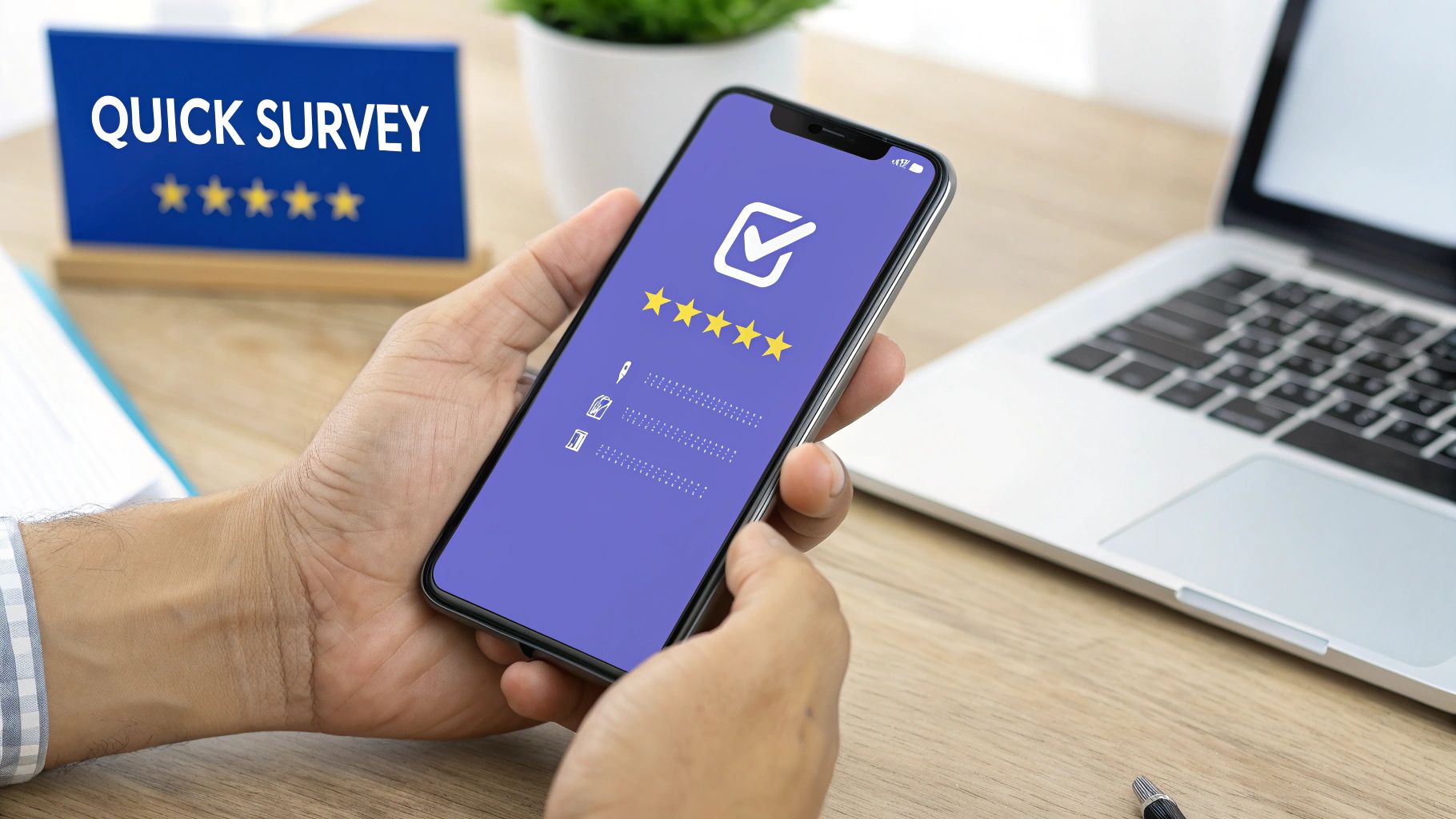
Let's be honest: an unanswered survey is a dead end. If you want to use surveys to drive more G2 reviews, you first have to convince customers to finish them. That means keeping your survey short, engaging, and simple to complete on a phone.
The psychology here is pretty straightforward. People are busy. Attention spans are short. If your survey feels like a chore, they’ll abandon it. That’s why you need to keep it to a maximum of 3-5 questions. You’re just taking a quick temperature check to find your happiest users.
Use Rating Scales to Quickly Find Advocates
Start with a simple, scalable question. The Net Promoter Score (NPS) is perfect for this. Asking "How likely are you to recommend our product to a friend or colleague?" on a scale of 0-10 instantly sorts your users into promoters, passives, and detractors.
Your promoters who score a 9 or 10 are your prime candidates for a G2 review. They have already told you they’re fans. This one question does most of the heavy lifting, letting you know exactly who to follow up with.
Another solid approach is a Customer Satisfaction (CSAT) score. After a support interaction or a new feature launch, a quick "How satisfied were you with [experience]?" can pinpoint those moments of delight.
A well-designed survey respects the customer's time. By using simple rating scales upfront, you make it easy for users to give you valuable data in seconds, increasing completion rates and identifying advocates without friction.
Ask Open-Ended Questions to Prime for a Review
Right after the rating question, follow up with one or two open-ended questions. This is where you get the customer to explain why they gave you that score. Their answer gives you incredible feedback and gets them thinking in review mode.
Good open-ended questions are specific and framed positively. Forget the generic "Any other feedback?" and try these instead:
- "What is the one thing you love most about our product?"
- "What was the main benefit you saw after implementing our software?"
- "Could you share a specific way our tool has helped your team?"
These questions nudge customers to recall positive outcomes. When they write down a specific benefit, they are mentally outlining the key points for a potential G2 review. You might even be able to repurpose their language for your marketing (with their permission, of course).
The way you word your questions has a huge impact on the quality of the response. Below is a quick comparison to show what works and what doesn't when you're trying to identify potential reviewers.
Effective vs. Ineffective Survey Questions for G2 Reviews
As you can see, the effective examples are all about guiding the user to think about value and positive experiences. This primes them perfectly for the next step: asking for the review.
Crafting a good survey question is a real skill. For a closer look, check out our detailed guide on what is a good survey question for more examples.
By keeping your survey short and strategic, you make it easy for customers to participate. The structure with a rating question first, then an open-ended question is a proven way to efficiently identify your biggest fans and get them thinking about the value they get from your product. This sets the stage perfectly for your G2 review request.
The Art of Timing Your Survey Requests
Knowing how to ask for a review is one thing, but knowing when to ask separates a campaign that drives tons of reviews from one that falls flat. If you send a survey at the perfect moment, you dramatically increase your chances of getting a response. It feels like a natural part of their journey, not an annoying interruption.
Think about the moments of peak happiness in your customer’s experience because those are your golden opportunities. Did a customer just finish your onboarding? Or maybe they just had a fantastic, problem-solving chat with your support team? These are the moments when their positive feelings are at their highest, and they're most willing to share that positivity.
Capitalize on Customer Success Milestones
One of the most effective strategies is tying your review requests to specific achievements within your product. When a user accomplishes something meaningful, they feel successful, and that positive feeling extends to your tool.
You can and should use product usage data to pinpoint these moments automatically. Look for signals that a customer is getting real, tangible value from your software.
- After a key feature is used for the first time: Think about that "aha!" moment when a user successfully uses a core feature that solves a major pain point for them.
- When they complete a project or task: If your tool helps users build or finish something, ask for feedback right after they hit "complete."
- Reaching a usage milestone: This could be anything from sending their 100th email campaign to closing their 10th deal using your platform.
By triggering a survey at these high points, you are tapping directly into their feeling of accomplishment. The request feels more relevant because it’s tied to the value they just received.
Leverage Positive Customer Interactions
Another perfect time to send a survey is immediately following a positive interaction with your team. A great customer support experience is a massive driver of loyalty and goodwill.
When a support ticket is marked as resolved and the customer leaves a high satisfaction rating, that's your cue. Don't wait a week. Trigger an automated survey request within a few hours. The customer is still feeling good about how responsive and helpful your company is, making them an ideal candidate for leaving a G2 review. The same logic applies after a successful quarterly business review or a positive call with their account manager.
The key is to make the survey request an immediate follow-up to a moment of delight. The recency of the positive experience makes customers far more likely to take the extra step to share their thoughts publicly on G2.
Market research shows a clear link here. Embedding surveys into the post-purchase or post-service experience can boost G2 review rates by 20% to 40%. Some vendors who implemented targeted surveys within 7-14 days of a positive interaction reported a 35% increase in G2 reviews in a single quarter. You can dig into more of these findings over at G2's own reporting.
Set Up Automated Triggers
Manually tracking all these moments is impossible. You have to automate it.
The solution is to set up automated triggers based on customer behavior and data. Connect your survey tool to your CRM, support desk (Zendesk, Intercom, etc.), and product analytics platform. This allows you to create workflows that fire off surveys automatically the second a customer meets your specific criteria. For instance, an embedded email survey can be triggered right after a positive support interaction, making it completely seamless for the customer to respond.
Automating Your G2 Review Generation Workflow
Manually sending surveys and chasing down customers for reviews doesn't scale. If you want to consistently bring in more G2 reviews, you need to build an automated workflow that does the heavy lifting while you focus on other things. The idea is to connect your survey tool with your CRM or customer messaging platform to create a seamless, hands-off review generation engine.
The goal here is to set up automated sequences that handle the entire process. This means sending an initial satisfaction survey, automatically identifying your happiest customers based on their scores, and then triggering a direct, personalized request for a G2 review. At the same time, this system can flag any neutral or negative feedback for your internal team to follow up on, turning a potential complaint into a chance to make things right.
Building Your Automation Stack
To get this machine running, a basic knowledge of workflow automation is super helpful. Most setups simply involve connecting a few key tools to pass information back and forth. You’ll generally need three core components:
- A Survey Tool: This is where you'll create and deploy your initial satisfaction survey, like an NPS or CSAT.
- A CRM or Messaging Platform: This is your customer database where you manage relationships (think HubSpot, Salesforce, or Intercom).
- An Integration Platform: A tool like Zapier or a native integration acts as the glue, allowing your survey tool and CRM to "talk" to each other.
The infographic below shows some of the best moments in the customer journey to trigger these automated survey requests.

As you can see, key events like finishing onboarding, closing a support ticket, or hitting a major product milestone are perfect opportunities to ask for feedback.
Creating the Workflow Logic
Your automation will run on simple "if/then" logic. For instance: IF a customer gives an NPS score of 9 or 10, THEN automatically send them a follow-up email with a link to your G2 review page.
On the flip side, you can set up a rule for detractors: IF a customer gives a score of 6 or below, THEN create a ticket for your customer success team to investigate. This makes sure any negative feedback is handled internally and proactively, not aired out on a public review site.
This two-pronged approach is the secret sauce. You’re systematically funneling your biggest fans to G2 while redirecting detractors to your support team for a white-glove resolution.
A 2025 G2 marketplace report found that companies using surveys this way can seriously ramp up their review velocity. Some saw gains of up to 50% in both the speed and volume of review submissions. This is especially true in the marketing and sales software space, where AI-powered survey tools can be woven directly into customer workflows. You can read more about the G2 report's findings on AI and customer feedback.
Platforms like Zapier make these connections incredibly straightforward. This screenshot gives you a glimpse of the available integrations with G2, letting you automate review requests from all sorts of triggers.

This just shows how you can hook G2 up to tools like HubSpot or Slack to create a fully automated system for both generating reviews and getting notified about them. It takes the manual work out of the equation and makes sure you never miss a chance to ask a happy customer for a review.
Analyzing Feedback and Following Through
Getting a customer to drop a G2 review feels like a huge win, and it is. But the work doesn't stop once the review goes live. The feedback you collect from both your initial surveys and the G2 reviews themselves is an absolute goldmine.
This data is your direct line into what your customers love, what trips them up, and what they secretly wish your product could do. Ignoring it is like leaving money on the table.
Your goal should be to treat every piece of feedback as a conversation starter. This means you need a solid system for organizing, analyzing, and actually acting on what you learn. It's how you turn a simple review campaign into a powerful engine for product improvement and customer loyalty.
Turning Feedback into Actionable Insights
First things first, you need to start categorizing the feedback rolling in. You don't need a fancy system to begin; you can create simple tags in a spreadsheet or your CRM to track common themes. This simple step helps you move beyond one-off comments to see the bigger picture.
Common categories might look something like this:
- Feature Requests: Direct suggestions for new tools or functionality.
- Usability Issues: Comments about the product being confusing or difficult to navigate.
- Praise for Specific Features: Positive shout-outs for particular tools or workflows.
- Support Experience: Feedback about interactions with your customer success team.
By tracking these themes over time, you can start spotting real trends. For example, if 15% of your new reviews all mention a desire for the same integration, that's a massive signal for your product roadmap. A structured approach is key, and our guide on analyzing survey data can walk you through more detailed methods.
The Importance of Closing the Loop
Analyzing the data is only half the battle. The other, equally important half is following through. When a customer takes time out of their day to leave a G2 review, whether it's glowing or constructive, they expect to be heard. Responding to every single review is non-negotiable.
For positive reviews, a simple and personal "thank you" goes a surprisingly long way. Acknowledge their specific comments and let them know you appreciate their support. This public engagement shows potential customers that you're an attentive and engaged company.
Responding to reviews is a marketing activity. Every public reply is a chance to reinforce your brand's values, highlight your commitment to your customers, and show prospects that you listen to feedback.
For constructive reviews, the response is even more critical. Thank the user for their honest feedback, acknowledge their issue, and, if possible, offer to take the conversation offline to get it resolved. This demonstrates transparency and a commitment to improvement, which can often turn a frustrated user into a loyal advocate.
This simple act of closing the loop shows you value your customers’ opinions and are genuinely interested in making your product better.
Common Questions About G2 Review Surveys
Thinking about using surveys to drum up more G2 reviews usually sparks a few practical questions. Nailing the details like incentives, follow-up messages, and timing can be the difference between a wildly successful campaign and one that falls flat.
Let's look at some of the most common concerns I hear from teams.
Should We Offer Incentives for G2 Reviews?
Yes, but you have to do it by the book. G2’s policy allows you to offer incentives like gift cards, but there's a catch: you have to offer it to everyone who leaves a review, regardless of whether it's a glowing five-star rating or a critical one-star takedown.
The trick is to frame it as a "thank you" for their time and honest feedback, not a payment for a positive review. That's a huge no-no. A small, neutral incentive can give you that extra bump in participation without compromising the integrity of the feedback. Always, always check G2’s latest guidelines before you launch anything.
Your messaging needs to be crystal clear. Something like: "We're offering a $25 gift card to thank you for your time in sharing an honest review on G2." This approach keeps you on the right side of G2's rules while still giving users a good reason to participate.
What Is the Best Way to Ask for a G2 Review in a Follow-Up?
Keep it direct, personal, and incredibly simple. The perfect time to strike is right after a customer gives you a high rating, such as a 9 or 10 on an NPS survey. That's your cue to trigger an automated email.
Make sure the message is personalized with their name and mentions the great feedback they just shared. For instance: "Thanks for your great feedback! We're so glad you're finding value in [Your Product]. Would you be willing to share that experience on G2 to help others?"
Then, and this is important, give them a direct link straight to your G2 review page. The goal is to eliminate every single bit of friction between their positive sentiment and the action of writing that review. Make it a one-click journey.
How Often Can We Send Survey Requests Without Annoying Customers?
There's no magic number here, but a solid rule of thumb is to avoid asking the same customer for a review more than once every 6-12 months. Your automation workflow should be smart enough to keep track of who you've already asked and, more importantly, who has already left a review.
Instead of sticking to a rigid calendar, focus your efforts on asking at the right moments in their journey. A positive support interaction, a key feature adoption, or a product milestone are your golden opportunities. If a customer doesn't bite on the first request, a single, gentle follow-up about a week later is fine. After that, let it go.
Ready to turn customer feedback into a powerful growth engine? Surva.ai gives you the tools to automatically identify your happiest customers and guide them to leave reviews on G2. Start collecting actionable feedback and boosting your social proof with Surva.ai today.
